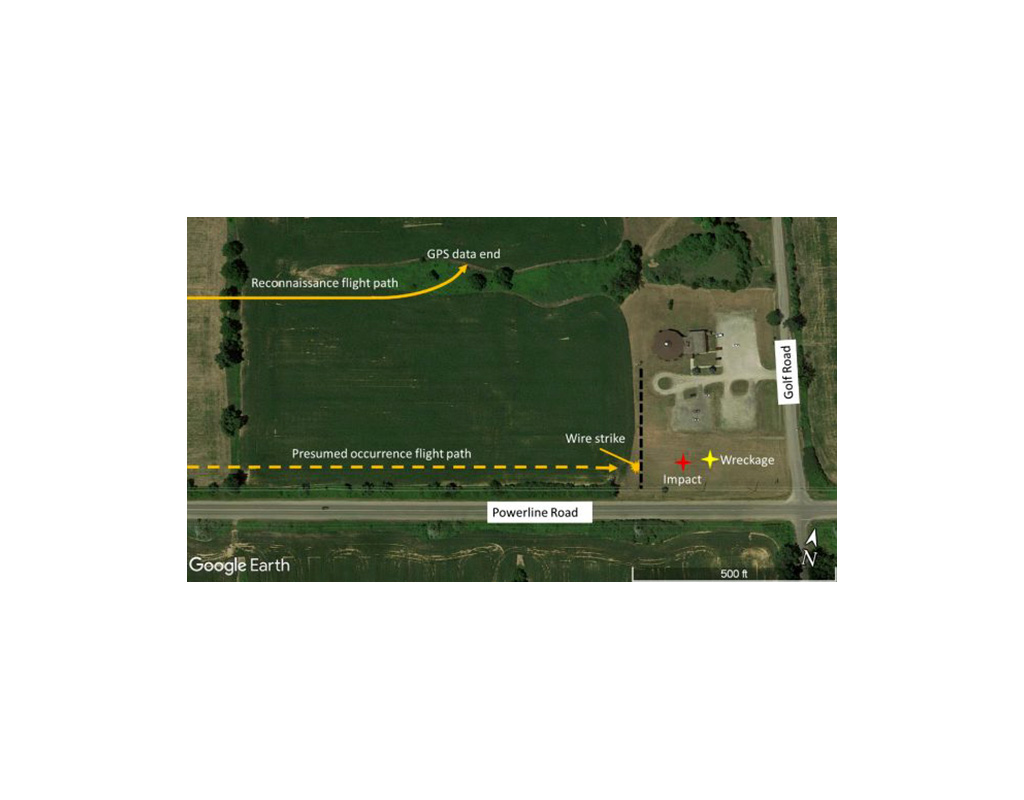
The Transportation Safety Board of Canada (TSB) has concluded that a wire strike was the cause of a July 2021 helicopter accident involving a Robinson R44 in Brantford, Ontario, operated by Apex Helicopters Inc., a company specializing in agricultural spraying.
The lone pilot on board sustained serious injuries in the July 25 crash. There was no post-impact fire, and the helicopter’s fuselage, main rotor blades, tail boom, and tail rotor remained mostly attached, but the skids, spray bar, and chemical tank detached when the aircraft crashed into the ground.
According to the Sept. 29 investigation report, the RR44 helicopter pilot was conducting an airborne reconnaissance that morning before spraying the fields at low altitudes of less than 100 feet (30 meters) above the crops. Shortly after the first spray, the aircraft struck wires at the southeastern part of the field and crashed about 270 feet (82 meters) from the wire strike location.
“The wires that were struck were significantly less prominent,” the TSB report stated. “Instead of running along a roadside or the church driveway, they ran along the edge of a corn field, which is not where pilots expect to see them, nor where they focus on scanning for hazards.”
The wire that the helicopter struck was also lower than other nearby wires, and the bases of its associated poles were obscured by corn.
Accident investigators said the pilot’s vision may have been impacted by the position of the sun, which, just after sunrise, was almost directly in front of the pilot’s flight path.
The sun’s glare, in addition to the possible film of spray fluid, dirt, or debris on the helicopter’s windshield, could have played a role in affecting the pilot’s forward visibility that morning, according to the report.
“The pilot likely would have had to focus her attention to the side of or below the direct sunlight to avoid looking into the glare,” the TSB report stated. “When flying low to the ground in a helicopter, not being able to see straight ahead makes detection of objects, such as wires, very difficult.”
Investigators also called attention to the terrain, which sloped down from west to east and lowered in elevation by about 30 feet (nine meters). Recreating the final moments of the flight that morning, accident investigators assumed the pilot would have been descending during the spray run, focusing her attention on the changing altitude and reducing the time she had to detect and avoid the wires.
And because the wires were strung between poles that were 38 feet (11 meters) above ground, it was likely they weren’t visible above the horizon until late in the spray run.
In addition, the report stated “the pilot’s frequent exposure to the risk of wire strike without a negative outcome likely altered the pilot’s risk perception and negatively influenced the thoroughness of the reconnaissance.”
While not found to be a safety concern in this incident, accident investigators made note that the emergency locator transmitter (ELT) was found in the ‘off’ position, which could have resulted in the accident going undetected and delaying any rescue or response efforts.
It’s unclear whether the ELT was turned off before the flight, or switched off sometime during the impact, but similar incidences with this model — a Kannad 406AF-Compact — prompted investigators to conduct a series of drop tests.
Preliminary testing found that the ELT dropped at heights of five feet or less and angled at around 45 degrees from vertical would “frequently move from the ‘arm’ position to the ‘off’ position due to the impact forces, despite the spring and mechanical guard designed to prevent this behaviour remaining intact.”
The report indicated that the ELT was “likely switched to the ‘off’ position during the impact with the ground, preventing it from sending a distress signal.”
Investigators said that the aircraft was maintained in accordance with existing rules and regulations, and the flight was operating within the guidelines outlined in the Canadian Aviation Regulations (CARs) and Commercial Air Services Standards (CASS). There was also no evidence of any pre-impact mechanical issues that would have affected the aircraft at the time of the incident.

